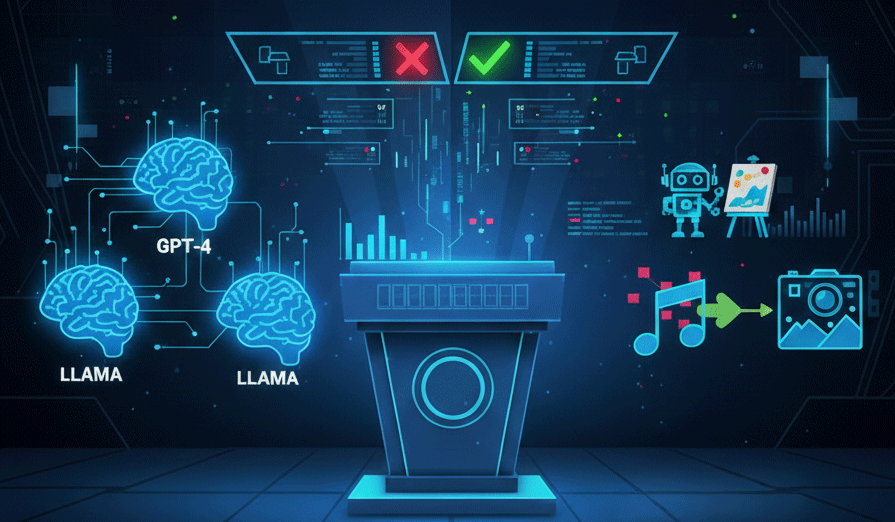Stay Ahead of the Curve: How AI/ML Strategies Future-Proof Your Business

Stay Ahead of the Curve: How AI/ML Strategies Future-Proof Your Business AI ML October 13, 2025 This is not just another blog on machine learning which will include words like synergize and agentic AI – which is why you should read it. We work to bring evidence-based information to you so you can pick and choose your strategy – which we help you finesse. By providing real-time, no-nonsense, practical solutions, we help you stay ahead of your competitors and grow your business rapidly and sustainably. So, what will we be covering in this blog? Well, at Tech360, we help companies in manufacturing, healthcare, legal, retail, and non-profit sectors to fundamentally rethink how they work and plan — with an AI/ML strategy that turns complex data into real business outcomes. Here, we show you exactly how we do it. Why AI/ML Matters More Than Ever Let’s start with the basics. Only briefly, to cover ground. Data is the new currency—and how you use it defines your competitiveness. Many businesses collect tons of operational data, but few are actually able to use it to make predictive, real-time decisions. The value-action gap, if you may—like we see with issues of environmentalism, for instance, where enthusiasts’ words and actions do not match. Another issue with this data is often found in unreliable data collection methods, too—and working on uncompromised data is a sure-fire way of razing down your shop before you even think of re-strategizing. To bridge the gap is where enterprise AI adoption comes in. AI and ML help companies automate manual tasks, spot inefficiencies, and act faster—often before a problem even surfaces. To tackle the second issue of data collection is where highly skilled technical talent, like researchers, come in—you may employ the best automation technique but without people essential for innovation, you will run into a circular problem. In short, AI-driven process optimization is how forward-thinking organizations are scaling efficiently and building resilience. AI/ML in Action: Real Industry Impact Let’s see how AI and Machine Learning are reshaping traditional sectors: 1. Manufacturing From predictive maintenance to automated quality inspection, AI in manufacturing helps reduce downtime and improve output.Machines can now sense early wear and tear, helping maintenance teams act before breakdowns occur. 2. Healthcare Hospitals and clinics use AI in healthcare for diagnostics, patient risk prediction, and administrative automation. It not only saves doctors’ time but also improves patient outcomes through faster, data-backed insights. 3. Legal Legal firms are leveraging AI for legal firms to analyze thousands of documents in minutes. Tasks like contract review, e-discovery, and compliance tracking have become faster, more accurate, and more affordable. 4. Retail Retailers are using machine learning in retail to personalize shopping experiences, forecast demand, and manage inventory better. The result? Happier customers and healthier profit margins. 5. Non-Profit Even the non-profit world benefits from AI for non-profit organizations. Predictive analytics help forecast donor behavior, measure program impact, and optimize limited resources for maximum social good. So, Is There a Roadmap to Staying Ahead? Success with AI/ML doesn’t happen overnight. It takes clarity, planning, and the right partner. Here’s how you can start: Begin with clear goals. When you focus on a few high-impact areas where AI can deliver measurable improvement, you are better able to narrow down your broad purpose, stay on track, and get hard numbers along the way. This strategy helps you tackle all areas of focus in the long run. Build a solid data foundation. Clean, well-structured data is the backbone of every successful AI initiative, so it is essential to ensure that your data is high-quality, well-organized, and accessible. Start with an audit of existing data if you must, to rule out inconsistencies. Start small, then scale. This sort of follows from the first point- test your ideas with pilot projects, prove ROI, and expand gradually. Once a pilot project shows positive results, you can gradually expand and integrate AI solutions across your business. This iterative approach reduces risk because you are able to iron out any challenges without committing significant resources upfront. Blend domain and data expertise. Combine the knowledge of your industry, domain, and subject matter experts with AI/ML strategy specialists. Nuances in strategy will allow you to take into account every possible perspective to keep you grounded in real-world relevance, and on track with your business goals. Prioritize explainability. Finally, trust is key, especially if you function in regulated industries. Build transparent systems that humans can understand and control, so they are more likely to trust and embrace them in turn. It might seem too much of an anecdote or behaviour-based policy consideration, but this is an evidence-backed strategy for faster and sustainable collaboration. Which ultimately leads to more successful AI integration within the organization. At Tech360, responsibility, accountability, and transparency are at the core of innovation. We help organizations create this balance—making predictive analytics for industries practical, compliant, and ready to scale. How Tech360 Makes It Happen At Tech360, we specialize in bringing AI to life across industries—without the technical overwhelm. We combine: Industry-specific insights: We have a deep understanding of your sector’s data and regulatory needs, be it in industries like manufacturing, retail, non-profit, healthcare, or legal, etc. End-to-end implementation: From data prep and modeling to deployment and governance, we handle every step of a process implementation and look after continuous improvement. Scalability and flexibility: We empower you to handle growing data volumes, complex workflows, and real-time analytics with ease, by assuming all workforce liabilities, so you can focus only on core work output. Regulatory security: Just as importantly, we embed security-first principles- like, data encryption, access control, and compliance with global data protection standards- at every stage. Responsible AI: Every model we build ensures human oversight which, simply put, means you can trust that your AI behaves predictably, treats data securely, and avoids unintended bias. Whether you’re exploring enterprise AI adoption or ready to deploy industrial AI applications, Tech360 is your strategic partner in intelligent transformation. Lead the Future, Don’t Chase It
LLMs vs Generative AI: The Family Feud You Never Knew You Had to Know!

LLMs vs Generative AI: The Family Feud You Never Knew You Had to Know! AI ML October 3, 2025 Ever wake up and wonder what the difference is between a Large Language Model (LLM) and generative AI? The rest of the world probably has. But here we are. One’s a mouthful, the other’s a buzzword, both are busy behind the scenes whipping up the digital soup we’re all now spooning into our eyes and ears and inboxes. What the Heck is Generative AI? Let’s get one thing straight: generative AI is not an optimistic toaster that writes poems about bread (although, in a way, it could be). Generative AI is a catch-all name for any system that’s trained not just to recognize or sort things, but to make stuff. It can whip up new text, images, music, code, probably a festive jingle about the sadness of Mondays. If creativity can be faked, generative AI is equipped for the job. Tools like Midjourney, Stable Diffusion, and whirring robot authors everywhere – they’re all generative AI. They learn from mountains of existing data (cat pics, books, legal documents, emoji wars) and, when prodded, assemble something new-ish. Fresh output, but only as fresh as the leftovers it was trained on. So, LLMs… Are They Just Generative AI’s Kid Brother or Something? Sort of, yeah. LLMs are Large Language Models. The big beasts trained on oceans of human text. The point? To model (simulate, copy, whatever) language so well that they can autocomplete, generate responses, summarize text, sell you vitamins, pretend to be Shakespeare – the works. GPT-4, PaLM, Claude, or that chatbot that promises to fix your spelling but instead invents a recipe for pudding with tomatoes in it. All LLMs. But LLMs focus on text. They are, in AI taxonomy, a subset of generative AI: all LLMs are generative, but not all generative AI are language models. “Cat generator” isn’t a poet, but an LLM might be. The Great Divide: What Sets Them Apart? Let’s put it this way: Generative AI is everyone at the talent show. LLMs are the kid who only does spoken word and sometimes murmury monologues about spaghetti. Generative AI can create images, music, videos, tahini sauce (okay, not that), whereas LLMs are obsessed with everything textual—stories, responses, code, translation, and making sure your email’s punctuation is only slightly deranged. Generative AI: “I’ll dream up faces, melodies, and fake news articles.”LLM: “I’ll text you about it.” Under the Hood: Tech Talk Without a Degree Generative AI runs on different breeds of neural networks: GANs (Generative Adversarial Networks), VAEs (Variational Autoencoders), and when it’s feeling fancy, Transformers. LLMs, for their part, worship at the altar of Transformers—models hungry enough to read a library and then forget your birthday anyway. Both need truckloads of data—words, images, videos, tweets, angry blog comments. LLMs especially binge on text: the bigger the training set, the cleverer (and maybe weirder) the output. Use Cases: Where the Magic Actually Happens Imagine a world where marketing teams don’t have to write their own press releases and artists can make ten thousand versions of a duck with sunglasses. That’s generative AI at play: Meme generation? Sure. Audiobooks narrated by robots? Done. AI-powered design tools that solve problems nobody had? Of course. LLMs, though? They’re in your support chat, your translation app, your school essays (oh, yes they are), your code autocomplete, your next great love letter to a pizza joint. Wait, Aren’t Some LLMs Getting into Images, Too? You’re right, wise reader. Since around mid-2023, some LLMs became “multimodal” (a word that would get you extra points in Scrabble, if the AI let you cheat). Multimodal LLMs can process stuff that isn’t just words—images, audio, all sorts of ancient memes—and then spit out a summary, description, or criticism, as if they’d been writing Yelp reviews for ages. Still, LLMs are best-in-class for text; generative AI is a bigger, weirder club—admitting anyone who can generate something, even if it’s only convincing to their algorithmic moms. The Blurry Line: Why Definitions Drive Professors Mad Every so often, tech folk love a Venn diagram. They’ll show you circles for AI, generative AI, LLMs, foundation models, machine learning, and probably a doodle of a raccoon for no reason. Where do LLMs end and generative AI begin? It gets hazy. A good rule: if the AI cooks up something that wasn’t before, it’s probably generative. If it can chat, summarize, translate, or write like your neighbor after three coffees, LLMs are probably behind it. But as multimodal LLMs handle images, video, and emoji, things start overlapping like socks after laundry day. Pitfalls of Both: It’s Not All Roses Generative AI can create deepfakes, art theft, and songs by people who never existed (no, the AI wasn’t at Woodstock). LLMs can make stuff up, hallucinate facts, confidently tell you that Paris is a breakfast cereal (double-check, always). Both risk inheriting biases, misinformation, and problems baked into their training data. But that’s the fun and danger. In the right hands, these models spark innovation. In the wrong hands, chaos, confusion, and ten million self-published AI novels that sound suspiciously like instruction manuals for assembling Swedish furniture. So, What’s The Takeaway/s? So: LLM versus generative AI isn’t a winner-take-all cage match. It’s the difference between a band and the lead singer. Generative AI is everything that makes and invents; LLMs are the ones writing limericks about your socks. Next time an AI spits out a pancake recipe or two paragraphs of existential angst about shoelaces, ask yourself: is this a generalist, or a specialist? Is it the full club, or just the poet looking for applause? The lines are fuzzy, the answers mostly made up on the fly; but hey; welcome to the future! Isn’t that just fantastic?! If a toaster writes you a sonnet, congratulations: you’ve met both.
